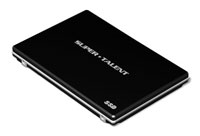Solid State Drives – Testing Reliability
 Demand for Solid State Drives (SSD) has grown in 2009 thanks to inexpensive controllers, and low cost high density MLC NAND memory chips. As one of the few data recovery shops specializing in NAND data recovery we’re often asked for our opinion on SSD hard drives. SSD is a relatively new and untested technology, aside from sparse manufacture documentation there isn’t much low level information on the internal design or reliability of these drives. JMicron has emerged as a leader in low cost SSD drives, their JMF602 controller is found in many SSD drives.
Demand for Solid State Drives (SSD) has grown in 2009 thanks to inexpensive controllers, and low cost high density MLC NAND memory chips. As one of the few data recovery shops specializing in NAND data recovery we’re often asked for our opinion on SSD hard drives. SSD is a relatively new and untested technology, aside from sparse manufacture documentation there isn’t much low level information on the internal design or reliability of these drives. JMicron has emerged as a leader in low cost SSD drives, their JMF602 controller is found in many SSD drives.
Background
While Solid State Drives have no moving parts they are still susceptible to power surges, component failure (capacitors, resistors, crystals, etc), and aging NAND memory. Pages in NAND memory which are frequently written to develop bit errors causing bits to arbitrarily switch values when read. ECC data is used to correct a limited number of bit errors and wear leveling is used to evenly write data across the entire drive by remapping blocks.
The SSD Drive
The test subject is a Super Talent MasterDrive OX (FTM16GL25H) 16GB SSD drive which uses a JMicron JMF602 controller rebranded as a Super Talent STT-C-02B-GL controller. It has eight Samsung K9GAG08UM (2GBit – MLC) NAND memory chips which provide 16GBits of raw storage. The drive reserves 1GB for wear leveling and spare sectors giving ~15GB of writeable space.
Reliability
People familiar with NAND memory acknowledge that NAND chips are only good for a specific number of writes. Turning that number into a tangible figure is difficult because the figure is somewhat arbitrary. If you use the drive more it will fail faster than if you don’t use it at all. To make failure rates more tangible manufactures give endurance numbers in gigabytes written per day over a number of years or in erase/write cycles.
In this case Super Talent says the 16GB MasterDrive OX will fail after writing 50GB/day to the drive for 8.8yrs, translating endurance into about 10K write cycles over the life of the drive.
50 x 365 x 8.8 = 160TB (Terabytes) of data written over the life of the drive 160000 / 8 (chips) / 2 (size of chip) = 10K Erase/Write cycles
To verify these numbers I used the linux command shred to write test patterns over 10,000 iterations. The command used was:
shred --random-source=/dev/zero -v -n 10000 /dev/sda
The Results
After three weeks of writing test patterns to the drive it failed after 4,068 write iterations. Less than half of the 10,000 cycles the manufacturer claims the drive is capable of.
4068 * 15 (logical size of drive) = 61TB of data written to the drive 61000 / 365 / 50 = 3.3 Years 4068 Cycles
I’m guessing Super Talent simply quoted Samsung’s datasheet without testing endurance themselves. Perhaps it’s an issue with Samsungs NAND memory chips or perhaps there is a bug in the drives firmware. Either way I’m not impressed with the drives reliability. While the average user won’t use the drive in this fashion the endurance numbers are off by more than half which will impact the average user.
What does a bad SSD drive look like?
In this case of “endurance failure” the drive appears to have locked itself in read only mode. The drive won’t allow writes to any sector however the drive is completely readable (ie: no bad sectors) and three unknown S.M.A.R.T. attributes are listed as “Failed in the Past”. If the drive failed for a regular user they wouldn’t be able to boot into windows however an advance user or computer tech could recover their data using ghost or a similar drive cloning program.
